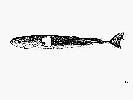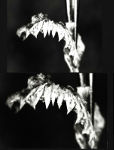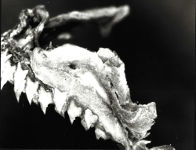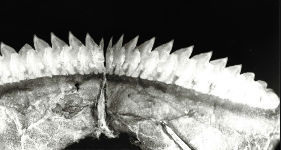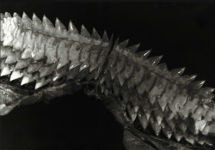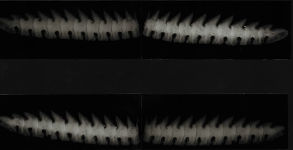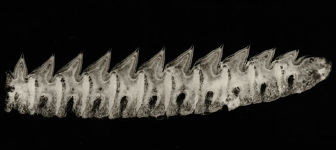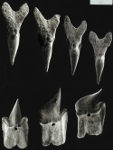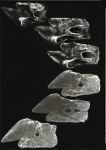Euprotomicrus bispinatus
(Quoy & Gaimard, 1824)
Pygmy shark
Classification: Elasmobranchii Squaliformes Dalatiidae
Reference of the original description
Description des Poissons. Chapître IX. In Freycinet, L. de, Voyage autour du monde, entrepris par ordre du roi. Exécuté sur les corvettes de S.M. l'Uranie et la Physicienne, pendant les années 1817, 1818, 1819 et 1820. Paris. Description des Poissons. Description des Poissons. Chapter IX.: 192–401 [1–328 in 1824; 329–616 in 1825], Atlas pls. 43–65
Description des Poissons. Chapître IX. In Freycinet, L. de, Voyage autour du monde, entrepris par ordre du roi. Exécuté sur les corvettes de S.M. l'Uranie et la Physicienne, pendant les années 1817, 1818, 1819 et 1820. Paris. Description des Poissons. Description des Poissons. Chapter IX.: 192–401 [1–328 in 1824; 329–616 in 1825], Atlas pls. 43–65
Image of the original description
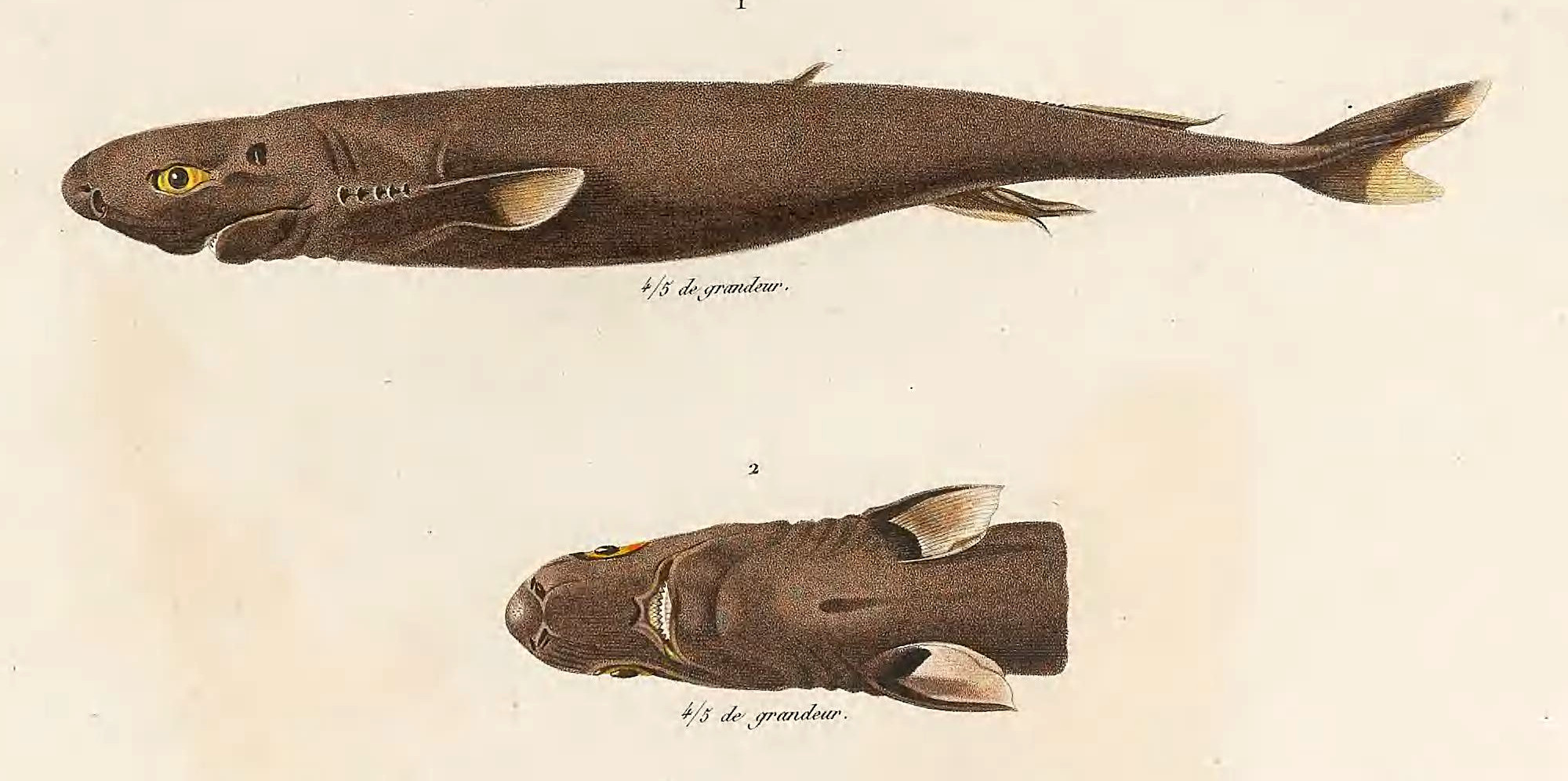
Scymnus bispinatus Quoy & Gaimard, 1824 valid as Euprotomicrus bispinatus (Quoy & Gaimard, 1824), plate 44

Scymnus bispinatus Quoy & Gaimard, 1824 valid as Euprotomicrus bispinatus (Quoy & Gaimard, 1824), plate 44
Synonyms / new combinations and misspellings
Dalatias (Somniosus) bispinatus, Euprotomicrus hyalinus, Euprotomicrus labordii, Laemargus labordii, Scymnus bispinatus, Scymnus mauritianus, Scymnus (Laemargus) labordii
Dalatias (Somniosus) bispinatus, Euprotomicrus hyalinus, Euprotomicrus labordii, Laemargus labordii, Scymnus bispinatus, Scymnus mauritianus, Scymnus (Laemargus) labordii
Types
Euprotomicrus bispinatus
Holotype: MNHN: 1216;
Euprotomicrus hyalinus
Holotype: CAS: 12715
Scymnus mauritianus
Holotype: MNHN: 1216;
Scymnus (Laemargus) labordii
Syntype: MNHN: ?
Euprotomicrus bispinatus
Holotype: MNHN: 1216;
Euprotomicrus hyalinus
Holotype: CAS: 12715
Scymnus mauritianus
Holotype: MNHN: 1216;
Scymnus (Laemargus) labordii
Syntype: MNHN: ?
Description :
Citation: Euprotomicrus bispinatus (Quoy & Gaimard, 1824): In: Database of modern sharks, rays and chimaeras, www.shark-references.com, World Wide Web electronic publication, Version 01/2026
Please send your images of "Euprotomicrus bispinatus" to info@shark-references.com
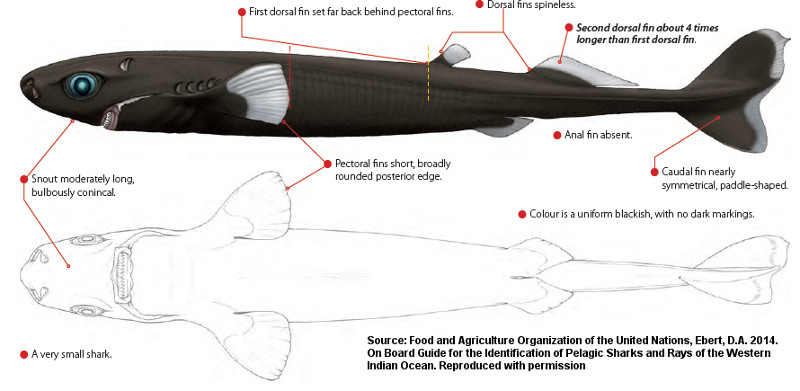
Euprotomicrus bispinatus (Quoy & Gaimard, 1824), © FAO, Food and Agriculture Organization of the United Nations, Ebert, D.A. 2014. On Board Guide for the Identification of Pelagic Sharks and Rays of the Western Indian Ocean. Reproduced with permission, illustration by Marc Dando , Wildlife Illustrator

Euprotomicrus bispinatus (Quoy & Gaimard, 1824), © FAO, Food and Agriculture Organization of the United Nations, Ebert, D.A. 2014. On Board Guide for the Identification of Pelagic Sharks and Rays of the Western Indian Ocean. Reproduced with permission, illustration by Marc Dando , Wildlife Illustrator
Common names
 Zwerghai,
Zwerghai,  Tiburón pigmeo,
Tiburón pigmeo,  Tollo pigmeo,
Tollo pigmeo,  Squale pygmée,
Squale pygmée,  Pygmy shark
Pygmy shark
 Zwerghai,
Zwerghai,  Tiburón pigmeo,
Tiburón pigmeo,  Tollo pigmeo,
Tollo pigmeo,  Squale pygmée,
Squale pygmée,  Pygmy shark
Pygmy shark
Short Description
Original Diagnosis after EBERT [22775]: Field Marks: Conical, moderately long, blunt, compressed snout, needle–like upper teeth and bladelike lowers, compressed body, gill slits increasing greatly in size from front to back, lobate, chimaera–like pectoral fins, midventral keel on caudal peduncle, no dorsal–fin spines, no anal fin, asymmetrical caudal fin, cloacal gland, dark colour with conspicuous light fin margins. Diagnostic Features: Anterior nasal flaps very short, not expanded into barbels; snout moderately long, compressed and conical, length about 2/5 of head length and less than distance from mouth to pectoral–fin origins; gill openings increasing in size from front to back, fifth over twice length of first; lips thick, fringed, but not suctorial; teeth strongly different in upper and lower jaws, uppers small, with narrow, acute, erect cusps and no cusplets, not bladelike, lowers much larger, bladelike, interlocked, with a high, broad, nearly erect cusp and distal blade, edges not serrated; tooth rows 29 upper jaw, 34 lower jaw. Both dorsal fins spineless; first dorsal–fin origin well behind free rear tips of pectoral fins, insertion about equidistant between pectoral and pelvic–fin bases and well ahead of pelvic–fin origins; second dorsal fin somewhat larger than first, base less than 1.5 times length of first dorsal–fin base; origin of second dorsal fin well ahead of pelvic–fin origins; pectoral fins with greatly expanded, broadly lobate free rear tips and inner margins, much as in chimaeras; caudal fin asymmetrical, not paddle–shaped, upper lobe long, lower lobe moderately long subterminal notch well–developed. No precaudal pits or lateral keels on caudal peduncle, but with a midventral keel. Dermal denticles flat and block–like, not pedicellate, no posterior cusps on flat, depressed crowns. Cloaca greatly expanded and modified as a luminous gland with secretory papillae. Vertebral counts and spiral valve turn counts not available. Colour: blackish brown with conspicuous light fin margins.
Original Diagnosis after EBERT [22775]: Field Marks: Conical, moderately long, blunt, compressed snout, needle–like upper teeth and bladelike lowers, compressed body, gill slits increasing greatly in size from front to back, lobate, chimaera–like pectoral fins, midventral keel on caudal peduncle, no dorsal–fin spines, no anal fin, asymmetrical caudal fin, cloacal gland, dark colour with conspicuous light fin margins. Diagnostic Features: Anterior nasal flaps very short, not expanded into barbels; snout moderately long, compressed and conical, length about 2/5 of head length and less than distance from mouth to pectoral–fin origins; gill openings increasing in size from front to back, fifth over twice length of first; lips thick, fringed, but not suctorial; teeth strongly different in upper and lower jaws, uppers small, with narrow, acute, erect cusps and no cusplets, not bladelike, lowers much larger, bladelike, interlocked, with a high, broad, nearly erect cusp and distal blade, edges not serrated; tooth rows 29 upper jaw, 34 lower jaw. Both dorsal fins spineless; first dorsal–fin origin well behind free rear tips of pectoral fins, insertion about equidistant between pectoral and pelvic–fin bases and well ahead of pelvic–fin origins; second dorsal fin somewhat larger than first, base less than 1.5 times length of first dorsal–fin base; origin of second dorsal fin well ahead of pelvic–fin origins; pectoral fins with greatly expanded, broadly lobate free rear tips and inner margins, much as in chimaeras; caudal fin asymmetrical, not paddle–shaped, upper lobe long, lower lobe moderately long subterminal notch well–developed. No precaudal pits or lateral keels on caudal peduncle, but with a midventral keel. Dermal denticles flat and block–like, not pedicellate, no posterior cusps on flat, depressed crowns. Cloaca greatly expanded and modified as a luminous gland with secretory papillae. Vertebral counts and spiral valve turn counts not available. Colour: blackish brown with conspicuous light fin margins.
Distribution
Circumglobal: In subtropical to temperate waters. Southeast Atlantic: near Ascension Island, east of Fernando de Noronha Island, and west of Cape of Good Hope, South Africa. Indian Ocean: Madagascar to Western Australia. North Pacific: Midway Islands, Hawaiian Islands to off California, USA. South Pacific: between New Zealand, Phoenix Island and southern Chile. Source: www.gbif.org
Circumglobal: In subtropical to temperate waters. Southeast Atlantic: near Ascension Island, east of Fernando de Noronha Island, and west of Cape of Good Hope, South Africa. Indian Ocean: Madagascar to Western Australia. North Pacific: Midway Islands, Hawaiian Islands to off California, USA. South Pacific: between New Zealand, Phoenix Island and southern Chile. Source: www.gbif.org
Human uses
fisheries: of no interest
fisheries: of no interest
Biology
Ovoviviparous, with 8 young per litter. Size at birth between 6 and 10 cm [518]. Distinct pairing with embrace [17086].
Ovoviviparous, with 8 young per litter. Size at birth between 6 and 10 cm [518]. Distinct pairing with embrace [17086].
Remarks
shark-references Species-ID=2252;
shark-references Species-ID=2252;
Parasites (arranged by Jürgen Pollerspöck)
Cestoda
Cestoda








